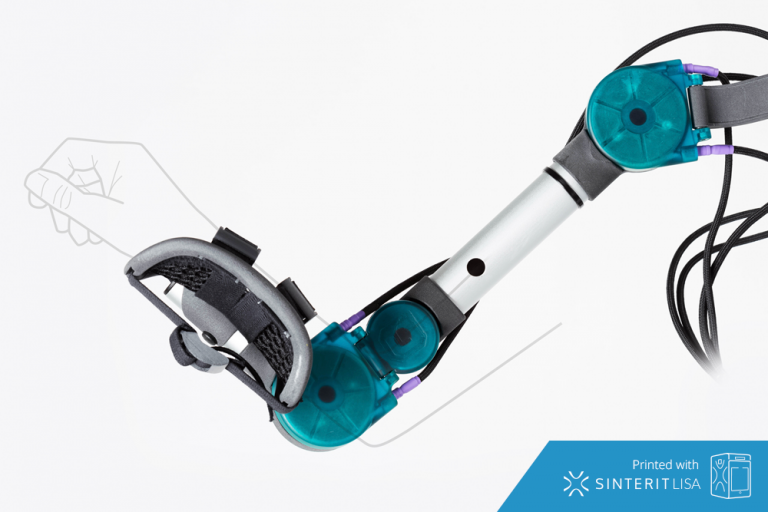![]() Tel:+86 135 7086 9158
Tel:+86 135 7086 9158
![]() Tel:+86 135 7086 9158
Tel:+86 135 7086 9158
PRODUCT LIST

 The ultimate aim of the research in medicine is to improve health, but there are still some areas that lack efficient answers when it comes to fighting diseases.
The ultimate aim of the research in medicine is to improve health, but there are still some areas that lack efficient answers when it comes to fighting diseases.
One of those is SMA (Spinal Muscular Atrophy). It is a genetic neuromuscular disease, which means it is inherited and affects nerves responsible for muscle function. Children with a less severe form of SMA face the prospect of progressive muscle wasting, loss of mobility and motor function. All over the world those children are not able to move without specialized external supportive devices.
A tailor-made exoskeleton arm is a device that allows them to move hands, to draw, play and express themselves – simply do what kids love to do. The idea came out from parents of children with SMA, who couldn’t find adequate solution. Radek was the kid, who moved his arms for the first time thanks to the solution developed by Barłomiej Gaczorek Design studio and printed on Sinterit Lisa 3D printer.
The challenge was to design and create cheap, affordable and easy to setup dynamic support exoskeleton arm for kids, which is ready to use out of the box. Child comfort and fun was always considered in the first place and determined the slick look of the device and choice of engineering solutions. Another thing we focused on was maximizing a flexibility of use and unburden the hand’s weight.
The whole process of production, involving 3D SLS printing technique was expected to be highly precise, time-efficient and as hands-free as possible to save the time of kids waiting for the possibility to move their arms.
Thanks to 3D printing and state of the art design tools we were able to meet all of those requirements. Autodesk Fusion 360 renders complex movement analysis and shapes optimization possible. The internally complex parts can be only produced by very precise 3D printing machine with strong, non-toxic materials. Without access to SLS 3D printer, prototyping of the device would be much more difficult and time-consuming.
 3D printing allows to significantly shorten the time of the designing, testing and developing stages of the exoskeleton arm for kids. That’s mainly due to the possibility of making and improving prototypes in-house in a matter of hours. SLS 3D printing allows to preserve required precision and tolerance (0.05 mm). The production of very detailed and solid models without the need to print any supports is a significant advantage of selective laser sintering. Another thing, but not less important, is the usability and feeling of the device by a disabled child. In the case of SLS, this feeling is definitely the best. The comfort of the child – the most important thing in this whole process – is here at the highest level.
3D printing allows to significantly shorten the time of the designing, testing and developing stages of the exoskeleton arm for kids. That’s mainly due to the possibility of making and improving prototypes in-house in a matter of hours. SLS 3D printing allows to preserve required precision and tolerance (0.05 mm). The production of very detailed and solid models without the need to print any supports is a significant advantage of selective laser sintering. Another thing, but not less important, is the usability and feeling of the device by a disabled child. In the case of SLS, this feeling is definitely the best. The comfort of the child – the most important thing in this whole process – is here at the highest level.
“I decided to print main elements in SLS technology, because it has complex internal structure. In other technology like FDM you would not maintain the required precision and tolerance (0,05mm) demanded for work with bearing. Additionally printing with FDM requires supports and its removing is time-consuming. Another thing is the comfort of user which is much better with SLS/SLA technology. The cost of Sinterit Lisa SLS printing is already very low compared to other industrial machines and the quality is perfect” explained Bartłomiej Gaczorek.
There are still many fields in medicine associated with improving motor skills, where 3D printing can be an alternative solution, easy to use and extremely precise. Exoskeleton arm for kids is just one of many possible uses of SLS 3D printing. The main thing is that Sinterit solutions are available today, affordable and easy-to-use.
Application of the 3D printing technology in the area of medicine, especially in the area of motor skills improvement is not a fancy daydream anymore. The use of 3D printing technique resulted in:
Exoskeleton author and initiator:
Bartłomiej Gaczorek Design studio
Copyright © Shenzhen Airboat Technology Co., Ltd. All rights reserved 【Backstage management】